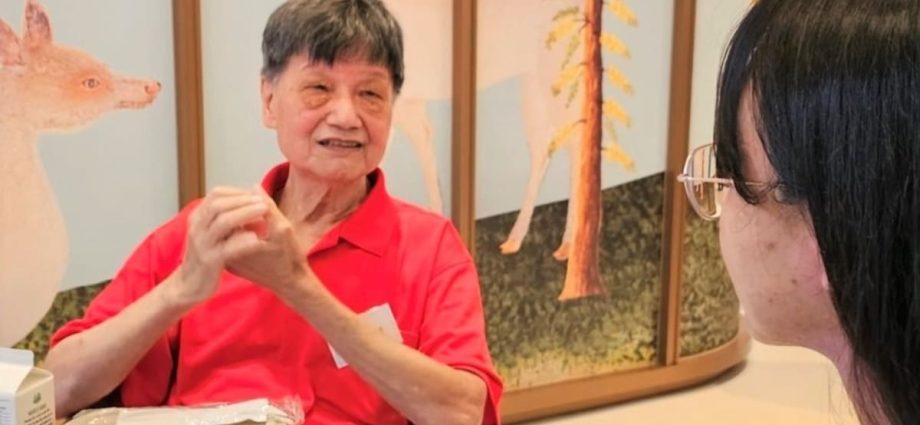
What intrigued the 20-somethings at my table, however, was how he got from Punggol to Orchard Road: by bus. It came as a surprise that almost 70 years ago, there were bus routes to Singapore’s rural areas.
We also learnt that bus rides were not stuffy back then — as we had imagined — but were cool and comfortable even with no air conditioning.
When asked why that was, Uncle Tan paused to think before suggesting that fewer roads and a lack of tall buildings meant Singapore was cooler then.
He had completed only primary school before he started working, but even without the years of formal education we are accustomed to nowadays, his answers were insightful. And his story challenged the stereotype of “uneducated” seniors I had unknowingly held.
PICKING UP LANGUAGES LEFT, RIGHT AND CENTRE
In his time as a coolie, Uncle Tan met people from round the world. Through these interactions, he learnt Malay, English and more.
The native Teochew speaker picked up Hainanese from the chefs he delivered groceries to and Hokkien while working in the market. At the same time, he was surprised by British officers who spoke fluent Hokkien and Cantonese.
As a student of linguistics and multilingual studies at university, I was floored.
Learning all these languages was not easy, Uncle Tan shared. But “nothing is ever easy”, he told us. English, for example, was utterly foreign to him. But he made the effort to learn it from the British officers he befriended.
As he wrote in Son of Singapore, “How is it there are all these foreigners speaking our languages, yet I cannot speak one of theirs?”
In a time before the Internet and the magic of instant translations, he managed to learn by talking to different people day after day and by carrying pocket dictionaries.
He is grateful to have learnt English all those years ago, he said. It stands him in good stead when he communicates with his grandchildren and great-grandchildren, who do not speak much Mandarin and no longer know their native Teochew.
“I talk to them in my broken English,” he said with a laugh and tapped his smartphone. “And they teach me how to use this!”
For him, learning to use the smartphone has been more difficult than picking up the languages he did.
‘TOO GOOD’ A STORY TO KEEP TO HIMSELF
His journey as a writer, on the other hand, started purely by chance — after he travelled to the United Kingdom with his British friends and experienced the hippy culture of the 1960s.
This new, Western world was a culture shock for him, coming as he did from conservative Singapore. It made him want his life story to be a legacy he could leave to his children.
Later on, while working in Hong Kong as a driver for a British diplomat he had befriended previously, he began to write Son of Singapore at night in his quarters.
The Briton, intrigued, asked if he could read the book. As it was written in Mandarin, Uncle Tan translated some excerpts and read them out to his boss.
“He told me, ‘Kok Seng, this is too good to keep to yourself! You must publish this,’” Uncle Tan recounted. “I told him there’s no way I can write this in English.”
His boss was insistent and offered to write it for him, so night after night, Uncle Tan went to his boss’s office and dictated the book. Together they penned it over the course of several months.
His first autobiography did so well he followed it up with Man of Malaysia, before he concluded his biographical trilogy with Eye on the World. Then his storytelling evolved as he wrote his only novel, Three Sisters of Sze.
That is four more books than he originally planned to write.
WHAT UNCLE TAN DOES NOWADAYS
As we came to the end of the conversation, I asked Uncle Tan what he does in his free time now.
He reads a lot: news, fiction, non-fiction and just about everything. “My eyesight still allows me to read, so I’m thankful,” he said.
We also asked him if he watched television very much, as some seniors do. He said he only really watches news and documentaries.
His love of storytelling made me realise how valuable it was to hear his stories in his own words.
Hearing about the intricacies of his life, I realised that history books do not do justice to the experiences of the generations before ours.
Besides Uncle Tan, the series Let Me Tell You A Story features Rasamal Nadayson, who was raised in poverty and was in an arranged marriage. Her story spoke to me because of the myriad of languages she spoke.
Lai Kum Yoong, meanwhile, was a midwife who once delivered a baby in a car, even though the baby had emerged backwards.
I could not hear their stories all in one afternoon, but the experience reminded me of the chats I had with my grandparents as a child and my sense of wonder at the people who have lived through Singapore’s history.
Watch the first episode of Let Me Tell You A Story here. The second episode airs on National Day at 9pm.

